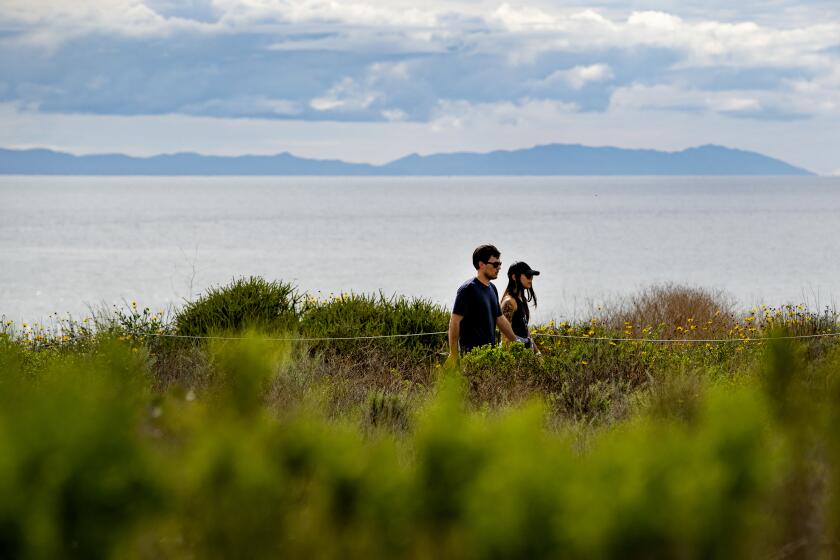Caution, Visitors: There May Be Danger in Them Thar Hills
Most of the signs for visitors to the Medicine Bow National Forest in southeast Wyoming are like those greeting people at most forests, with the requisite rules about camping, fires and vehicle use.
But on a section of Medicine Bow between Cheyenne and Laramie, visitors see an additional sign -- warning them not to pick up metal objects that could be unexploded military ordnance.
From 1879 until 1961, when the U.S. Forest Service took over the land from the Defense Department, the forest’s 64,000-acre Pole Mountain area served as a military target and training range.
Now, a team of specialists is combing the ground here for old mortar shells and other ordnance as part of a nationwide effort to make former military ranges on federal and private lands safer for public use.
“We have no records since 1961 of anybody getting hurt, or even livestock damaged or hurt, from any munitions,” district ranger Clinton Kyhl said. “But we obviously know there is a risk.”
The task, given to the Army Corps of Engineers here and elsewhere, is enormous.
“Right now we are aware of about 2,400 former ranges across the country,” said Julie Kaiser, project management specialist for the Army Corps of Engineers working on the program dubbed Formerly Used Defense Sites, or FUDS. “The bulk of them are old World War II training ranges.”
The former defense sites cover an estimated 15 million acres, and almost every state and U.S. territory has at least one. Conservatively, it is estimated it could cost $12 billion to remove all the ordnance.
“It’s a very expensive prospect to pick up every single piece of what might be ordnance,” Kaiser said.
Although there have only been two cases nationwide over the last 20 years of anyone being hurt or killed by old military ordnance, the federal government is spending $145 million over a six-year period to assess and inspect each site for the danger posed by unexploded munitions.
Sites where munitions were found previously, where some type of construction or digging is planned and which are currently open to public use, such as Medicine Bow, are ahead in the process.
Similar investigations are under way at Camp Hale in the White River and San Isabel national forests in Colorado and the Mark Twain National Forest in Missouri, said John Miller, a corps project manager from Omaha.
At Pole Mountain, mortar shells, small arms ammunition, artillery projectiles and even a case of dynamite have been found on the ground in the past. But now, “it’s pretty rare we find this stuff on the surface,” Kyhl said. “After 30 or 40 years, pretty much all the surface stuff has been found.”
What worries Kyhl and others now is buried ordnance.
Miller said the underground ordnance remained a danger because frost could slowly push objects to the surface over time.
The corps has hired American Technologies Inc., based in Oak Ridge, Tenn., to help it determine where buried ordnance might exist at Pole Mountain and whether any areas need to be cleared.
Since Aug. 8, about two dozen technicians and explosives experts have been crisscrossing the rugged terrain at more than 8,000-foot elevation with metal detectors. They use hand-held detectors and a 3-foot-wide wheeled contraption that a technician with headphones pushes along while carrying a backpack of electronics.
“It’s basically a mine detector,” said D.J. Myers, an ordnance and explosives safety specialist with the corps.
The teams completely covered 12 campgrounds. Since it’s impossible to cover every inch of the 64,000 acres -- about 100 square miles -- they traversed lines strategically mapped out at points in the forest where soldiers once fired their weapons.
Myers figures the teams will cover about 1% of the Pole Mountain area.
Anything they come across is carefully marked, recorded, dug up or -- in the case of munitions -- blown up.
They found two 3-inch-wide, 18-inch-long practice mortar rounds on the ground during a preliminary search, but other than that their greatest fears and problems have come from the start of hunting season and cows that have a penchant for knocking over and breaking stakes the technicians use to mark their survey paths.
The information they gather will be used by corps officials to determine if any further investigation is needed or if any effort to remove ordnance is warranted.
Kyhl said he didn’t believe any large scale cleanup effort was needed. The information would probably come in handy if the Forest Service should see the need to build a new road or campground, he said.
Meantime, the Forest Service uses pamphlets, displays and signs to warn people not to touch suspicious metal objects, to mark the location if possible and report it to rangers or police.
“The message is: If you see it, don’t pick it up. Walk away and report it,” Kaiser said.
Sign up for The Wild
We’ll help you find the best places to hike, bike and run, as well as the perfect silent spots for meditation and yoga.
You may occasionally receive promotional content from the Los Angeles Times.



